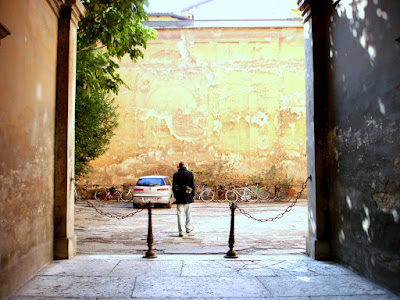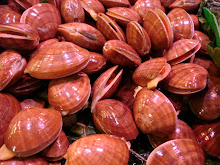
Olive oil has been cultivated since at least 4000 BCE (the earliest amphorae were apparently found from around 3500 BCE), and while olives have been an important part of the culinary history of the Mediterranean, they were not always as important in Italy as today. One might imagine that the Romans simply imported the alimentary habit from Greece, but the turning point in the olive's position in Italy actually happened much later, during the mid 14th century.
As any history buff will tell you, there was really only one important event in Europe during the 14th century, and that was the black death. In Italy alone the population went from 10 million in 1340 to around 6 million by 1400 (for reference, Italy's population is now about 60 million and shrinking). Before the plague, Italy was a self-sufficient peninsula agriculturally speaking, growing its own grain and feeding its population through lots of hard manual labor. But much of Italy is very hilly, and thus not ideally suited to growing grain. Grain works better where you don't have to work so hard to get the water to the fields, and Italy ignored this fact through sheer numbers. However once the plague hit things needed to change. There were no longer enough people to grow all the grain that the country (I use the term for convenience, not because Italy was a single country at this time) needed, and it was necessary for them to manage their labor force with more care.
The solution ended up being to switch to a cash monoculture: olives. Olives need certain things to grow well: lots of space, soil with a certain PH and moisture level, lots of sun, a fair amount of rain, etc, etc. The Italian peninsula happened to be a perfect match, and with all the dead people there was suddenly a lot more space cropping up. So the survivors started to plant olive trees on these hills, and decided that growing olives was a lot easier than growing grain. They then pressed the olives for oil and traded it out to get their grain instead. The more efficient use of resources and labor led to an improvement in the quality of life in Italy, as well as the proliferation of the olive tree. (Much thanks need to go to Prof. Michael McCormick for teaching me all this and to Ellen Bryson for helping me remember it.)
On Monday our class took a field trip to the
Fattoria Casamora, an agroturismo and olive farm. Here we were greeted by a man who would generally be referred to by his coworkers as "the architect", because not only was he the person who runs the olive farm and oversees the production of the oil, but he also happens to be a full time architect. He designed all the spaces inside this beautiful Italian farmstead, and also designs buildings all around Italy. His real name is Maurizio.

The architect first gave us a tour of the building, including a very large amount of public space used for the guests of the agroturismo. An agroturismo is essentially an Italian country bed and breakfast, which happens to also be a farm. They are usually known for their fabulous food, fresh from their land, and are definitely a wonderful way to experience the uniqueness of Italy and to learn about a less well-known facet of Italian culture.
The spaces were all minimalist and contemporary, very clean and comfortable. The giant lecture hall could have easily sat 70 or 80 people at least, and they even had minimalist solo piano music playing in there, just for the ambiance. This place was not a small operation, but despite that it felt like something unique and to be treasured, just 40 minutes outside of Florence.
The architect gave us a much more detailed description of the equipment than we really needed, and definitely more than I understood. It also didn't help that they had asked us to wear our chef jackets (photo op) for the day, so we weren't wearing our coats. This was the coldest day of the year so far, and inside these huge spaces with no heating it couldn't have been above 60 degrees. But what I gathered was that they use several different techniques to make their oil, though I couldn't quite understand why.

The farm actually grows six or eight different varieties of olive, and they make separate oils for each varietal. You can definitely tell that the olives produced different tasting oils--some were spicier on the finish, others milder, and we discussed what kinds of dishes and food you would pair with each variety. Oils of this quality, we were told, are never heated up; the heating process denatures the oil and ruins the subtle flavor. Rather these oils are for using raw, as a final garnish to a finished plate. And they were so wonderful and fragrant, I could definitely imagine the right oil bringing a dish to a whole new level. The picture to the side was of the casks where they store the oil over the course of a year: each one was labeled clearly with what kind of oil was inside and what the bin number was. Each bottle they fill of oil also has this same information on it, so if there is ever a problem with one of the oils, they can track it straight back to the source (or, more likely, if someone treats the oil wrong and complains, they can show that their oil isn't the one with the problem).

All of us took turns stepping out of the tour to warm ourselves by the roaring fire they had set up for us. Here Medhi takes his turn. It doesn't get this chilly in Casablanca! Despite the cold, it was a really beautiful experience.
While we are still unsure as to why we were being used for advertising purposes, Annie definitely looked great as a Vanna White for a 5 liter jug of oil. She took the job mostly because it gave her an excuse to stand by the fire.
Luckily for us, after the tour we were asked to sit down for a late afternoon snack of sorts, where the farm showed off one of its other specialty products: Tuscan beans. They made us a wonderful, hot tuscan bean soup, heavily flavored with rosemary, and then gave us a challenge: the soup needed to be dressed with olive oil to finish it off, and so we had to decide for ourselves which oil we liked best with this dish. They set a beautiful table with small bottles of all the oil their farm makes.
I took seconds, ostensibly to try a different oil and soup combination. It was a wonderful soup. Really highlighted the quality of the beans through a very simple combination. They served a lovely chianti red with the soup, and were extremely generous with all their portions.

Continuing with the theme of traditional Tuscan food, they ended the only way a proper Tuscan meal can: cantuccini and vin santo. Cantuccini are little biscotti with almonds in them, very sweet and crunchy, and vin santo is a white dessert wine, sort of similar to a moscato or a sweeter, white sherry. Of course they served a vin santo that they had made on the property, and had pulled out a bottle from 1991 to share with us. We were more than happy to help finish off every drop of it, and during the process were regaled with a complex story about the time the archietct had met the pope and been given something. At this point all the wine was getting to me though, and even if I could have understood the story in the best of shape, well I wasn't going to understand it then. The architect liked telling it though.
On the whole this was a wonderful outing, a chance for us to bond a bit as a class, learn more about a very special part of Italian culinary culture, and enjoy an evening outside of Florence. This really showed off some of the very best parts about Italy, and I couldn't help but want to stay there for much longer.
 The gardens were absolutely lovely. There were lots of plants around with lovely scents, including lemon trees at almost every corner, and so you were not only visually engaged in the garden but olfactory-ally as well. The way the garden was designed meant that around every corner there was a surprise. While the garden pictured here is lovely, can you see through the archway? That archway is for the limoneria, a barn for storing lemon trees through the winter, and as you pass through it there are a huge set of stairs dropping down into a completely different style of garden. Let me zoom in for you:
The gardens were absolutely lovely. There were lots of plants around with lovely scents, including lemon trees at almost every corner, and so you were not only visually engaged in the garden but olfactory-ally as well. The way the garden was designed meant that around every corner there was a surprise. While the garden pictured here is lovely, can you see through the archway? That archway is for the limoneria, a barn for storing lemon trees through the winter, and as you pass through it there are a huge set of stairs dropping down into a completely different style of garden. Let me zoom in for you:  After the tour I got to stay for tea, which was done in a proper British style and was really lovely and fun. I got to talk with Susan the guide some more and met one of the other people who works there who I had been in contact with to arrange the tour. We discussed the differences between the Villa and the American Academy in Rome, and conversed about life in Italy for expats. I thought it was a lovely place, surrounded by lovely countryside (and some 80 acres of grape and olive farms, or something like that), and had a very academic air to it. How beautiful!
After the tour I got to stay for tea, which was done in a proper British style and was really lovely and fun. I got to talk with Susan the guide some more and met one of the other people who works there who I had been in contact with to arrange the tour. We discussed the differences between the Villa and the American Academy in Rome, and conversed about life in Italy for expats. I thought it was a lovely place, surrounded by lovely countryside (and some 80 acres of grape and olive farms, or something like that), and had a very academic air to it. How beautiful!
























































